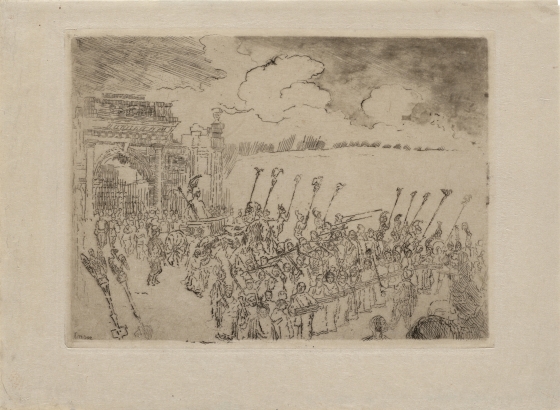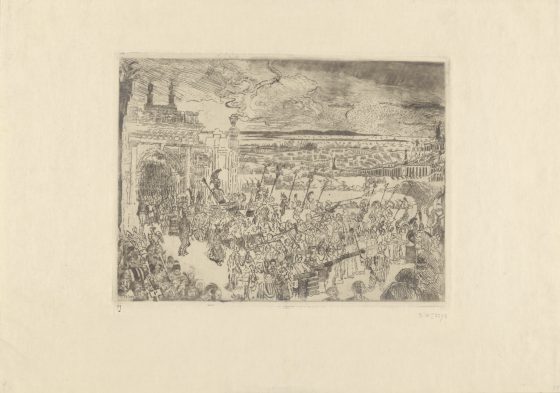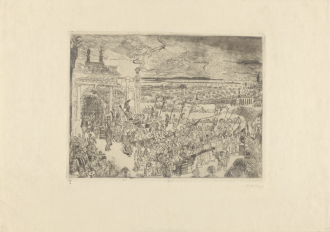This archived website ‘James Ensor. An online museum.’ is temporarily not being updated. Certain functionality (e.g. specific searches in the collection) may no longer be available. News updates about James Ensor will appear on vlaamsekunstcollectie.be. Questions about this website? Please contact us at info@vlaamsekunstcollectie.be.
'Roman Triumph' by James Ensor
End 1890 or early 1891 James Ensor executed a print, titled Triomphe romain (Roman Triumph). (fig. 1) It has been engraved on a bevelled copper plate, measuring 179 x 241 mm. The etching, measuring 173 x 235 mm without the bevels, has been reproduced for the first time in the special issue of the French art magazine La Plume (1899), dedicated to James Ensor. (1) It depicts a triumphal entry of the Roman conquering armies in Rome. Ensor is not referring to a specific known Roman Triumph, although he could be inspired by Julius Caesar’s life, as described in his copy of the French translation of Plutarchus’ Lives of the Noble Greeks and Roman, commonly called Parallel Lives. (2) And he could, of course, also have been inspired by Andrea Mantegna’s famous Triumph of Caesar. Several series of engravings have been made by Italian and non-Italian engravers after Mantegna’s work. One of those series is executed in 1692 by the Flemish engraver Robert Van Audenaerde (1663-1748). The depicted arch could be inspired by the Arch of Constantine on the Via Triumphalis, or by the Arch of Septimus Severus on the Forum Romanum, both in Rome.

Ensor’s print was inventoried and reproduced by Loys Delteil, Albert Croquez, Auguste Taevernier and James N. Elesh in their respective catalogue raisonné. (3) Delteil signals that the print is also known as Entrée d’Alexandre [Entry of Alexander] and Taevernier titles the print Roman Victory. They all dated the print ‘1889’. Émile Verhaeren also mentions the print in his monograph on the painter, published in 1909, and classified it under the year 1889. (4) The date given by all the Ensor print specialists is not correct. In a letter, dated 5 January 1891, James Ensor writes to Valère Gille (1867-1950), editor of the art journal La Jeune Belgique: ‘I am executing an etching: a Roman Triumph, pretty lively subject. Numerous crowds. A forest of statues. Crouched triumph arches, frail aqueducts, little streets jammed by a strange population, lions dragging tanks, elephants and dromedaries, giraffes and unicorns, Indian warriors riding on ostriches, tumultuous archers, heavy reared-up cavalry, lictors preceded by numerous trumpets, serene Caesars, haruspices observing each other without laughing, grotesque musicians, etc. Vivid agitation in an impossible landscape and a sky crossed by the rain and the sun. If the biting succeeds, I will offer you a proof as a token of my gratitude and the pleasure I had to be published by La Jeune Belgique.’ (5)
The letter reveals us that the print dates from end 1890 or early 1891, and not from 1889. Ensor himself dates it 1889. Between 10 and 28 January 1891, Ensor writes to his Brussels friend and patron Mrs Rousseau (1850-1926): ‘I am very happy with the proofs, especially Roman Triumph. There are opposite tonalities and some pleasant distinctions in the line work. But why Bouwens did sent only one proof of this etching and pulled on Holland paper.’ (6) Ensor mentions the Brussels printer Joseph Bouwens (1823-1895) who pulled Ensor’s early proofs. On 30 January 1891, Ensor writes to Valère Gille: ‘The Roman Triumph is not well pulled. You will see a drawn and engraved reduction at the salon of Les XX. I will send you a small proof, afterward a large one, if I succeed to save it.’ (7) Ensor mentions a drawn and an engraved ‘reduction’ of the subject, and also a ‘large’ and a ‘small’ proof of the print. The small drawn ‘reduction’ is the drawing in coloured chalks on panel (36 x 46 cm), owned by the Print Room of the Royal Library of Belgium (inv. no. S II 29334). It was shown at the 8th salon of Les XX (Brussels) in 1891. (8)
The Louvre (Paris) owns a sketch study of the subject, in black Conté pencil on paper (172 x 226 mm) (inv. no. RF 39526 recto). The question remains if Ensor executed two different prints after the same subject? Apparently, Ensor executed the print after the larger (drawn or engraved) composition, which dates from 1890, and that, most probably, no longer exists. In his letter, dated 8 December 1890, to Mariette Rousseau, he writes: ‘In order to relax, I am executing a phantasmagorical Roman Triumph on a large panel, a forest of white statues, several heavy Hercules crouching tragic monuments, massive triumph arches, frail aqueducts, sinuous small streets jammed by strange populations. Elephants and giraffes, lions dragging tanks, unicorns and hippopotamuses, Indian warriors riding on ostriches, tumultuous archers, heavy reared-up cavalry, baroque musicians, worried and stunned population, haruspices observing each other without laughing. I keep in my brains designs for vague novels, strange muddles, marmalade of giants, indefinite succession, clear and vague, passing by in great speed. Adventures of the giant Andropine of the pretty Fessine, etc., etc. I filled 80 pages with these marvellous adventures and I take pleasure in it, all written in a jumping, dishevelled, rebellious, tight and loose style, making madly pirouettes, figures without any connection, not knowing each other, and arriving in tight rows, a constantly renewed disorder, without truce, all moving on the setting of an impossible landscape.’(9)
There are two known states of the etching. The first state shows the sky and the background unfinished, and without the figures at the lower left. In the second state, the sky and the landscape in the background have been completed, and the figures at lower left have been added. Some figures at the right border have also been added. Two sculptures were added on the arch. A corner of a building is seen at the left border. The first state is very rare. The Kupferstichkabinett of Dresden is the only public institution that owns a proof in the first state (inv. no. 1894-450). It is pulled in brownish black on Japan paper and has been acquired in August 1894, along with fifteen other Ensor prints. (10) The Print Room of the Royal Library of Belgium in Brussels owns a proof in the second state (inv. no. S II 53373). (fig. 2)

It was acquired, along with 24 other Ensor prints, in 1892 from Dietrich & Co., a famous Brussels book- and print shop. (11)
The print (in the final state) was published as a bonus for the subscribers of the Brussels satiric magazine Le Diable-au- Corps, year 1895, pulled on Holland paper by the Brussels printer Léon Evely (1849-1937), in an edition of about 50 proofs. (12) It has also been published as part of the portfolio Douze Eaux-fortes [Twelve Etchings], pulled on Japan paper, in an edition of 50 numbered copies, by the Brussels printer Jean-Baptiste Van Campenhout (1864-1927) in 1896. (13)
Footnotes
(1) James Ensor Peintre & Graveur, avec 111 illustrations de James Ensor, Paris, Librairie de la Société Anonyme La Plume, 1899, p. 57.
(2) James Ensor owned a copy of Plutarchus’ Vies des Hommes Illustres, published by Firmin Didot (Paris) in 1868. It is currently in the archives of of Mu.zee (Ostend).
(3) Loys Delteil, Le Peintre Graveur Illustré. Tome Dix-neuvième: Henri Leys - Henri de Braekeleer - James Ensor, Paris, Chez l’Auteur, 1925, no. 78 (not paginated; not illustrated); Albert Croquez, L’Œuvre gravé de James Ensor, Geneva-Brussels, Éditions Pierre Cailler, 1947, no. 78 (not paginated; not illustrated); Auguste Taevernier, James Ensor. Illustrated Catalogue of his Engravings, their Critical Description and Inventory of the Plates, Ledeberg (Ghent), Impr. Erasmus, 1973, no. 78, pp. 196-197 (ill.); James N. Elesh, James Ensor. The Complete Graphic Work (The Illustrated Bartsch, vol. 141), New York, Abaris Books, 1982, no. 78, p. 142 (ill.).
(4) Émile Verhaeren, James Ensor, Brussels, G. Van Oest & Cie, 1908, p. 127.
(5) James Ensor, Lettres, edited by Xavier Tricot, Brussels, Labor, 1999, pp. 424-425
(6) Archives of Contemporary Arts of Belgium, Royal Museums of Fine Arts of Belgium, Brussels, Rousseau Records, inv. 119.749.
(7) James Ensor, Lettres, p. 426.
(8) Brussels, Musée de Peinture, Les XX, 8th yearly exhibition, 7 February – 8 March 1891, cat. no. 9.
(9) Archives of Contemporary Arts of Belgium, Royal Museums of Fine Arts of Belgium, Rousseau Records.
(10) The Ensor prints (inv. nos. 1894-448 to 1894-463) acquired in 1894 by the Kupferstichkabinett, Staatliche Kunstsammlungen, Dresden, are: The Cathedral (first plate) (1886), Christ Calming the Storm (1886), Roman Triumph (1890-91), Capture of a Strange Town (1888), Devils Trashing Angels and Archangels (1888), Ernest Rousseau (1886), Elias Magnus Fries (1886), Rue du Bon Secours, Brussels (1887), View of Ostend to the East (1888), Windmill at Mariakerke (1889), Windmill at Slykens (1891), Sloops (1888), Squall at the Edge of the Woods (1888), The Pier at Ostend (1887), Music on the Rue de Flandre, Ostend (1890) and Large View of Mariakerke (1887).
(11) The Ensor prints (inv. nos. S II 53354 to 53378) acquired in 1892 by the Print Room of the Royal Library of Belgium, Brussels, are: Music on the Rue de Flandre, Ostend (1890), Town Hall of Audenaerde (1888), Rue du Bon Secours, Brussels (1887), House on Boulevard Anspach, Brussels (1888), Footpath at Groenendael (1888), View of Ostend to the East (1888), The Rustic Bridge, Ostend (1889), Flemish Farm (1888), The Wood Bridge, Ostend (1889), Boulevard Van Iseghem, Ostend (1889), Clump of Trees (1888), Peculiar Insects (1888), The Windmill at Mariakerke (1888), The Cataclysms (1888), Christ Mocked or Christ Shown to the People (1886), Sloops (1888), The Large Dock of Ostend (1888), Christ Calming the Storm (1886), Capture of a Strange Town (1888), Roman Triumph (1890-91), Grounded Boats (1888), The Cathedral (1886), The Pond at the Poplars (1889), Iston, Pouffamatus, Cracozie, and Transmouff, Famous Persian Physicians, Examining the Stools of King Darius after the Battle of Arbela (1886). See Bibliographie de Belgique, year 8, no. 7, 1892, p. 195, no. 32: ‘ENSOR (James). Eaux fortes. Bruxelles, Dietrich. 25 pl. sur chine petit format, en un portefeuille in-fol.’ (Chine paper was once used to indicate Japan paper).
(12) Le Diable-au-Corps, year 2, no. 52, 30 December 1894, p. 2.
(13) The portfolio Douze Eaux-fortes, in an edition of 50 copies, contains the following proofs of etchings pulled on Japan paper: The Battle of the Golden Spurs (1895), The Multiplication of the Fishes (1891), The Bad Doctors (1895), House on Boulevard Anspach, Brussels (1888), Fridolin and Gragapança of Yperdamme (1895), Christ and the Beggars (1895), Demons Teasing Me (1895), Capture of a Strange Town (1888), Roman Triumph (1890-91) and The Windmill at Slykens (1889).
Etching (copper plate, bevelled)
179 x 241 mm
1st state
The sky and the background have not yet been finished. The figures at lower left are missing. Signed lower left corner: Ensor
2nd state
The sky and the landscape have been completed, and the figures at lower left have been added. Some figures at the right border have been added. Two sculptures have been added on the arch. A corner of a building is seen at the left border.
Editions
- Print published as a bonus for the subscribers of the Brussels satiric magazine Le Diable-au- Corps, year 1895, pulled on Holland paper by the Brussels printer Léon Evely (1849-1937), in an edition of about 50 proofs (cf. Le Diable-au-Corps, year 2, no. 52, 30 December 1894, p. 2).
- Print published in the portfolio Douze Eaux-fortes, printed on Japan paper, in an edition of 50 numbered copies by Van Campenhout (Brussels) in 1896.
Bibliography
Reproduced for the first time in La Plume, p. 57. Also reproduced by Le Roy, p. 121. Delteil, Croquez, Taevernier and Elesh reproduce the second state. Delteil mentions that the print is also known as Entrée d’Alexandre. Taevernier entitles the print Roman Victory.
Remarks
In a letter, dated 5 January 1891, James Ensor writes to Valère Gille (1867-1950), editor of the art journal La Jeune Belgique: Je fais une eau-forte: un triomphe romain, beau sujet mouvementé. Foule innombrable. Forêts de statues. Arcs de triomphe trapus, aqueducs grêles, ruelles encombrées d’étrange population, lions traînant chars, tigres dressés, éléphants et dromadaires, girafes et licornes, guerriers indiens montant des autruches, sagittaires tumultueux, lourde cavalerie cabrée, licteurs [illegible word] précédés de trompettes innombrables, Césars sereins, Augures se regardant sans rire, musiciens grotesques, etc. Vive agitation dans un paysage impossible et ciel rayé de pluie et de soleil. Si la morsure [est] réussie, je vous offrirai une épreuve témoignant la reconnaissance et le plaisir que j’ai éprouvé de paraître dans la Jeune Belgique [James Ensor, Lettres, Brussels, Labor, 1999, pp. 424-425]. The letter reveals us that the print dates from end 1890 or early 1891, and not from 1889. Ensor himself dates it 1889. On 30 January 1891, Ensor writes to Valère Gille: ‘Le triomphe romain n’est pas bien venu. Vous verrez une réduction dessinée et gravée au Salon des XX. Je vous enverrai la petite épreuve et après la grande, si je parviens � la sauver [Lettres, p. 426]. Apparently, Ensor executed the known drawing and print after a larger (engraved) composition, which dates from 1889, and, probably, no longer exists.
The print, pulled by Léon Evely, has been announced in the Brussels satiric journal Le Diable-au-Corps (year 2, no. 52, 30 December, 1894, p. 2). The print was a bonus for the new subscribers of the magazine, and was sold 25 francs for the non-subscribers.
Description
Ensor depicts a triumphal entry of the Roman conquering armies in Rome. Elesh asserts that Ensor’s interest in Belgian history is shown in this print. He thinks that the presence of the windmill at the extreme right border indicates that this scene depicts Julius Caesar’s invasion of and victory over Gaul in 57 B.C. We do not think Ensor is refererring to a specific known Roman Triumph, although he could be inspired by Caesar’s life, as described in his copy of Plutarchus’ Vies des Hommes Illustres, published in 1868 by Firmin Didot (Paris). And he could, of course, also being inspired by Andrea Mantegna’s famous Triumph of Caesar. Several series of engravings have been made by Italian and non-Italian engravers after Mantegna’s work. One of those series is executed in 1692 by the Flemish engraver Robert Van Audenaerde (1663-1748). The depicted arch could be inpired by the Arch of Constantine on the Via Triumphalis, or the Arch of Septimus Severus on the Forum Romanum, both in Rome.
Related works
- Roman Triumph, 1890, coloured chalks on prepared panel, 36 x 46 cm, Print Room, Royal Library of Belgium, Brussels (inv. no. S IV 29334) [Haesaerts, no. 246, p. 379; ill. classified catalogue 156, p. 321; Ghent/Amsterdam, 1987, no. 76, p. 95; Hoozee/ Taevernier/ Heijbroek, no. 95, p. 143; colour ill. p. 235; Brussels, 1999-2000, no. 269, p. 290]. The drawing has been shown at the 8th salon of Les XX (Brussels) in 1891 (cat. no. 9).
p.p1 {margin: 0.0px 0.0px 0.0px 0.0px; font: 12.0px Helvetica; color: #0433ff; -webkit-text-stroke: #0433ff} span.s1 {font-kerning: none}
- Roman Triumph (sketch study), c. 1890, Conté pencil on paper, 17,2 x 22,6 cm, Musée du Louvre, Paris (inv. no. RF 39526 recto) [Ghent/ Amsterdam, 1987, p. 100; Hoozee/ Bown-Taevernier/Heijbroek, ill. p. 189].







